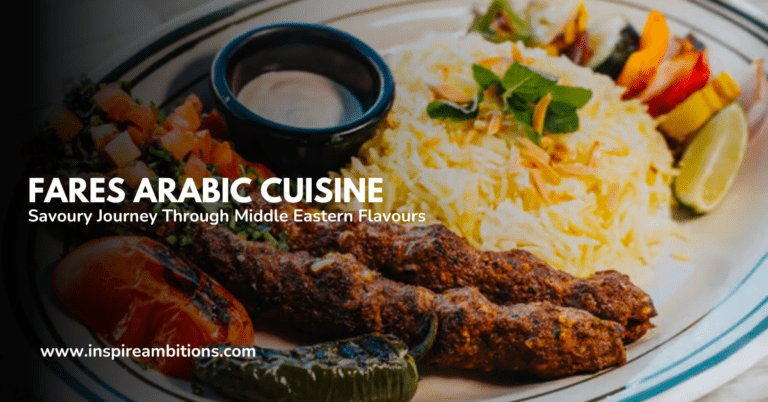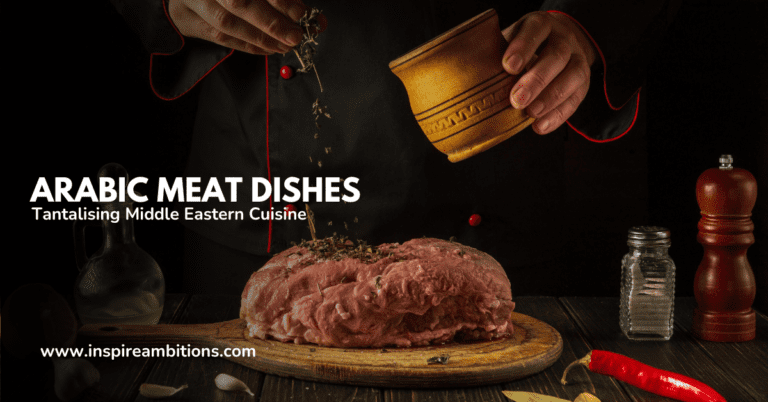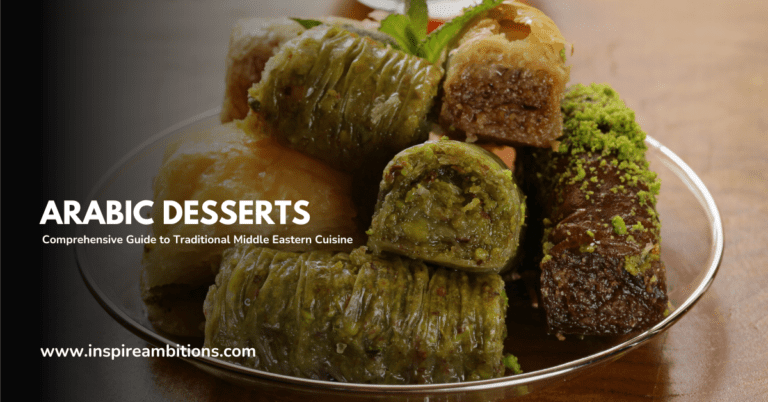阿拉伯鸡——为您的味蕾带来美味享受
Arabic chicken dishes are renowned for their exquisite flavours and unique combinations of spices and herbs.
As you delve into the world of Arabic cuisine, you will find that these recipes often incorporate aromatic ingredients such as cumin, which impart a smoky and nutty flavour to the dishes, giving them a distinct character.
One popular dish you might encounter is Kabsa, a one-pan meal consisting of chicken or other meat options such as lamb, goat, beef, or seafood, cooked with long-grain basmati rice and an array of fragrant spices.
Alternatively, you might be tempted by a Lebanese 7-spice chicken, served with basmati rice and a side salad, offering a delicious meal for a quiet weekday dinner or a special Sunday supper.
Exploring Arabic chicken recipes will undoubtedly leave you with a newfound appreciation for the complexity and diversity of this cuisine.
As you try your hand at more of these dishes, you will not only expand your culinary skills but also treat your taste buds to a delightful adventure through the rich flavours of the 阿拉伯世界.
History of Arab Chicken
Arab cuisine has a rich history, influenced by various ancient civilisations of the Middle East, such as the Sumerians, Babylonians, Phoenicians, and Egyptians.
Over time, iconic dishes like chicken biryani, shawarma, and other chicken-based meals emerged, embodying different flavours and cooking techniques.
Chicken biryani, for example, has its roots in the Arab world. This popular dish consists of rice, vegetables, and chicken, offering a delightful and versatile meal suitable for any occasion.
While its exact origin is uncertain, it is believed to have been influenced by the ancient Arab traders and their travels through the Indian subcontinent.
Shawarma is another beloved 中东 dish with a history tracing back to the Ottoman Empire.
This dish features chicken or other meats, sliced into thin layers, stacked in an inverted cone, and roasted on a slowly turning vertical spit. Shawarma has become popular across the world, adapting to local ingredients and preferences in each region.
Throughout the centuries, Arab chicken dishes have evolved, blending with Berber, Andalusi, Mediterranean, European, and sub-Saharan influences.
Moroccan cuisine, for instance, is an excellent example of this culinary intersection between Arab and other culinary traditions.
In summary, the history of Arab chicken dishes is an intricate weaving of diverse regional and cultural influences.
With each dish carrying its own unique story and flavours, the evolution of these recipes serves as a testament to the ever-changing nature of Arab cuisine.
Cooking Arab Chicken
让我们开始。
原料
Arab chicken recipes often incorporate a blend of rich spices, herbs, and various cooking methods, resulting in distinctive and flavourful dishes. Key ingredients include:
- Chicken: whole, drumsticks, thighs, or breast
- Basmati rice or similar long-grain rice
- A mix of spices and herbs: cumin, paprika, coriander, cinnamon, cardamom, black pepper, turmeric, etc.
- 蒜
- 洋葱
- Olive oil or vegetable oil
- 柠檬汁
- Tomato paste or chopped tomatoes
- Chicken stock or water
- Salt and pepper, to taste
- Optional garnishes: fresh coriander, toasted nuts, and raisins
制备方法
- Marinating the chicken: In a large bowl, combine your selected spices, minced garlic, and olive oil. Add the chicken pieces and make sure they’re entirely coated with the marinade. Allow the chicken to marinate in the refrigerator for at least 3 hours, preferably overnight for maximum flavour.
- Cooking the chicken: There are various methods to cook the marinated chicken, depending on the recipe or your preference. You may choose to grill, bake, or pan-fry the chicken pieces. It’s essential to cook them until fully cooked through and golden brown on the outside.
- For grilling, preheat the grill on medium-high heat. Place the chicken pieces on the grill and cook them for 6-7 minutes per side, depending on the thickness of the meat.
- For baking, preheat the oven to 200°C (400°F). Place the chicken pieces on a baking tray and bake them for 30-40 minutes, turning them halfway through the cooking time.
- For pan-frying, heat a large non-stick pan with a drizzle of oil over medium-high heat. Cook the chicken pieces for 6-8 minutes per side, until cooked through and golden brown.
- Preparing the rice: Rinse the rice several times in a strainer with cold water. In a large saucepan, heat some oil and sauté chopped onion and garlic until they’re softened. Add your choice of spices, and cook for a few more minutes. Stir in the drained rice, tomato paste (or chopped tomatoes), chicken stock (or water), and salt and pepper to taste. Bring the mixture to a boil, then reduce the heat, cover, and simmer for about 20 minutes or until the rice is cooked and fluffy.
- Optional garnishing: Before serving, you can garnish the dish with additional chopped fresh coriander, toasted nuts (such as almonds), and raisins for added flavour and texture.
Now you have everything you need to prepare a delightful Arab chicken meal at home. Enjoy your culinary adventure into the flavours of the Middle East!
Distinctive Arab Chicken Spices
Arab chicken dishes are known for their rich and aromatic flavours, which can be attributed to the distinctive combination of spices used in their preparation.
As you create your own Arab-inspired chicken dishes, consider incorporating some of these traditional spices to achieve authentic, mouth-watering results.
小茴香 is one of the most popular spices in Arab cuisine, adding a smoky and nutty flavour to your chicken dishes. It’s often used in marinades or spice blends, playing a key role in achieving that distinct Middle Eastern taste.
香菜 lends a citrusy and slightly nutty flavour to Arabic chicken dishes and can be used either ground or in its whole seed form. It is also commonly found in spice mixes and works well to complement the other flavours in your dish.
姜黄 is another important spice in Arab cuisine, adding a vibrant yellow colour and potential health benefits to your chicken dishes. While it doesn’t have a strong taste, it contributes to the overall appeal of your dish and is typically used alongside other spices.
多香果 is a key ingredient in many Arab spice mixes, including the well-known Lebanese 7-Spice blend. It adds warmth and complexity to your chicken dishes and pairs well with other spices such as cinnamon and cumin.
肉桂 is another popular flavour in Arab cuisine, used in both sweet and savoury dishes. When added to your chicken, it imparts a subtle, sweet warmth that enhances the overall character of the dish.
This versatile spice works well in combination with other spices, particularly allspice and cumin.
Remember, achieving the perfect balance of flavours is crucial in Arab cuisine. As you experiment with these spices, make sure to adjust the quantities to suit your palate whilst staying true to the essence of traditional Arab chicken dishes.
With attention to detail and a confident approach, you’ll be able to create delicious, aromatic chicken dishes with an authentic touch.
Arab Chicken Varieties
Arab chicken recipes make use of a variety of spices and herbs, contributing to their distinct and flavourful profiles. Some common spices and herbs used in Arabic cuisine include:
- 小茴香
- 香菜
- 辣椒
- Nutmeg
- 小豆蔻
- 肉桂
- Saffron
- 漆树
- 扎阿塔尔
- 哈努特角
One popular Arabic chicken dish is Al Faham chicken, which is marinated in a blend of spices, yoghurt, and olive oil before being grilled.
The marination process allows the flavours to seep deep into the chicken, resulting in a tender, juicy, and flavoursome dish.
Kabsa is another well-known Arabic chicken dish that varies by region. It is a one-pan, rice and meat-based dish with rich spices baked into long-grain basmati rice.
Traditionally, the meat is either chicken or lamb, but goat, beef, and even seafood options can be used as well.
In the United Arab Emirates, local residents raise chickens in coastal desert areas, where summer temperatures can reach up to 120 degrees Fahrenheit (49°C) with 70 per cent humidity.
Some common chicken breeds raised in the region include Rhode Island Reds and related crosses, which are typically reared in the US and the UK.
In Saudi Arabia, there is a focus on classifying local chicken breeds based on their phenotypic and genetic characteristics.
With the risk of extinction for the native domestic breeds, attention and effort are required to conserve and preserve these potentially valuable genetic resources.
Remember, when preparing Arab chicken dishes, the key to their unique and tantalising flavours lies in the creative use of spices and herbs.
Enjoy exploring these varieties and experimenting with the rich, diverse flavours that make Arabic chicken recipes so delightful.
Health Benefits of Arab Chicken
Arab chicken dishes, which often incorporate a variety of spices and herbs, can offer numerous health benefits for your body. One of the primary advantages is that chicken is an excellent source of lean protein.
Protein plays a vital role in building and maintaining stronger bones and muscles, as it provides essential amino acids that your body needs.
When you consume Arab chicken recipes, you not only benefit from the protein but also from the use of spices, such as turmeric and cumin.
These spices have antioxidant properties, which help protect your body’s cells from damage caused by free radicals. Additionally, they possess anti-inflammatory qualities, which can aid in reducing inflammation and improving overall health.
Moreover, Arab chicken dishes often incorporate vegetables and whole grains, such as rice, couscous, or bulgur. These additions contribute to a more balanced meal that provides vitamins, minerals, and fibre.
Fibre is particularly important for maintaining good digestive health, as it promotes regular bowel movements and helps prevent constipation.
Finally, many Arab chicken recipes use healthier cooking methods, such as steaming or grilling, instead of deep-frying.
These methods help reduce the amount of added fat and calories in the dish, contributing to better weight management and heart health.
In summary, incorporating Arab chicken dishes into your diet can provide a range of health benefits, including lean protein for muscle and bone strength, antioxidants for cellular protection, anti-inflammatory properties, and fibre for improved digestion.
Additionally, you can enjoy these benefits without compromising taste or flavour, thanks to the diverse range of spices and herbs used in Arabic cuisine.
Pairing Suggestions for Arabic Chicken
When enjoying Arabic chicken dishes, it’s essential to find the perfect accompaniments to enhance the overall dining experience. Here are a few pairing suggestions to inspire your next meal.
- Rice: Arab cuisine often features rice dishes that go hand in hand with chicken. Basmati rice is a popular choice, providing a fragrant and delicate base for the flavours of the chicken. You can try the Middle Eastern version of basmati rice, making it the ideal side for dishes like Lebanese Chicken with 7-spice.
- 沙拉: Light, refreshing salads can provide a welcome contrast to the complex flavours of Arabic chicken. Lebanese Tabouli is a popular option, combining parsley, mint, tomatoes, and onions with a simple lemon and olive oil dressing. Alternatives include a more substantial Lebanese Slaw or a mixed vegetable salad with olives, pickles, and other tangy ingredients.
- 面包: Flatbread is a staple in Middle Eastern cuisine and serves as a delicious way to mop up sauces and soak up flavour. Pair your chicken dish with an authentic Arabic flatbread, like pitta or lavash, or try some crispy, flaky Samoon for an added crunch.
- Dipping Sauces: Chicken Shawarma, a common Arabic chicken dish, wouldn’t be complete without a delicious garlic sauce to drizzle over the top. Explore a variety of other complementary dipping sauces, such as tahini, hummus, or even a spicy harissa sauce, depending on your personal preference and the dish you’re serving.
- Drinks: When it comes to beverages, consider serving a refreshing yet flavoursome drink that complements the spices used in your Arabic chicken dish. Traditional options include mint lemonade, pomegranate juice, or a yoghurt-based Ayran. Alternatively, if you prefer something with a little more kick, a fruity red wine or a fragrant, aromatic white wine can work well.
By pairing your Arabic chicken dishes with these suggested accompaniments, you’ll create a harmonious, well-rounded meal that showcases the richness and complexity of Middle Eastern flavours.
Arabian Chicken – Conclusion
In your exploration of Arab chicken, you have delved into various aspects of this unique breed. From its rich historical background to the current efforts in conserving its genetic diversity, Arab chicken has made a significant impact on the world of poultry.
Throughout your research, you came across multiple sources emphasising the importance of preserving the native Arab chicken breeds. These birds are in danger of extinction due to modern breeding practices.
Therefore, it is essential for you to recognise the value of conserving their genetic resources.
As you learned about the various Arab chicken breeds, such as the Kedu and Poncin, you gained insight into their distinctive characteristics and growth patterns.
This understanding allowed you to appreciate the versatility of these breeds, which can be used both for meat and egg production.
When examining Arab cuisine, you were introduced to a rich culinary tradition, replete with flavours and techniques that highlight the use of chicken in various dishes.
From tajines to hariras, the Arab chicken is a central ingredient in many mouth-watering creations.
By drawing on your newfound knowledge, you are now better equipped to explore and appreciate the incredible world of Arab chicken.
Armed with this understanding, you can contribute to the ongoing conversations surrounding heritage chicken breeds and their place in modern poultry production.
In summary, by studying Arab chicken, you have opened the door to a fascinating world of heritage breeds that contribute to the rich culinary traditions we enjoy today.







